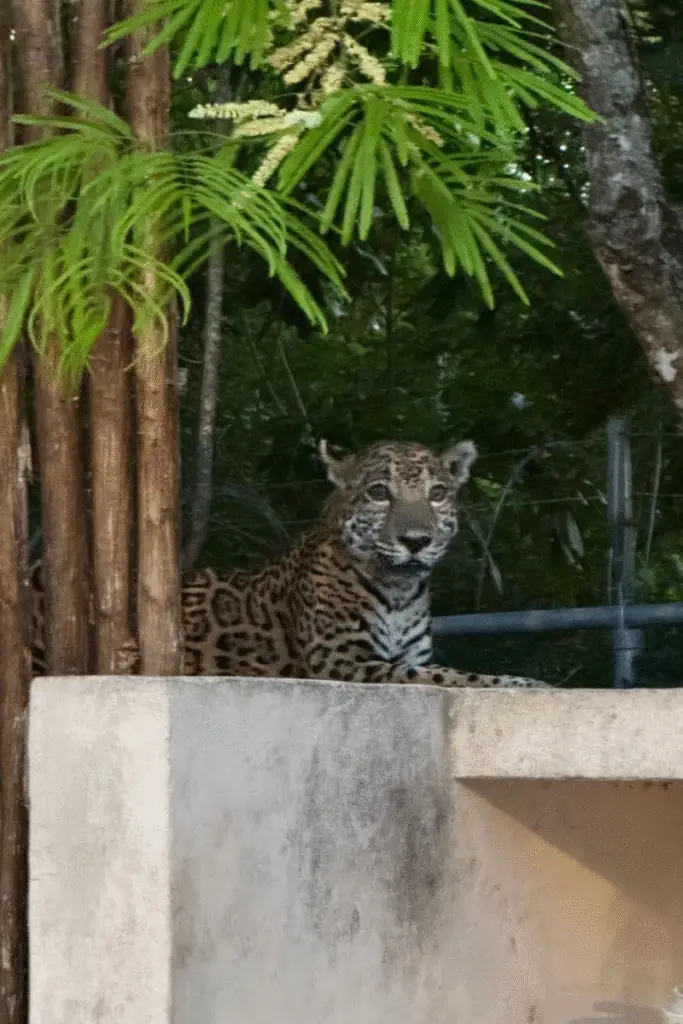A rare and striking sighting of a wild jaguar in Puerto Aventuras has sparked both awe and concern, underscoring the ongoing conflict between urban development and wildlife conservation in the Riviera Maya.
The big cat was observed by a resident on the northern border of the gated community. He was able to catch a single photograph of the jaguar before it disappeared back into the darkness—a fleeting encounter that reflects a deeper reality. As development—including the building of highways and trains—fragment the region’s jungle, encounters between humans and jaguars are becoming more common.

Jaguars in Mexico
Table of Contents
Jaguars, the third-largest cat in the world, are native to Mexico. Their habitat extends from Mexico to Argentina, with Brazil being home to around half of the wild jaguars in the world. According to the National Commission of Protected Natural Areas (CONANP), healthy populations of jaguars require an extensive environment to thrive. One specimen needs between 2,500 and 10,000 hectares of land, as well as a network of connected territories.
Five Fun Facts About Jaguars
They Have the Strongest Bite of Any Big Cat
Jaguars can bite down with over 1,500 pounds of force—strong enough to pierce a turtle’s shell or crush a crocodile’s skull. Unlike lions and tigers that typically suffocate their prey, jaguars often kill with a single skull-crushing bite.
They’re Excellent Swimmers
Unlike many cats, jaguars love water. They swim across rivers, hunt fish, and even ambush prey from the water’s edge. The wetlands and cenotes of the Yucatán Peninsula are natural jaguar territory.
Their Name Means “He Who Kills in a Single Leap”
The word “jaguar” comes from the Indigenous Tupí-Guaraní word yaguareté, roughly translating to “true beast” or “he who kills in one leap.” It’s a nod to their speed and lethal ambush attacks.
They’re Masters of Stealth
A jaguar’s rosette-spotted coat isn’t just beautiful—it’s camouflage. In dappled jungle light, these patterns break up the jaguar’s outline, making it nearly invisible even at close range.
Not All Jaguars Are Spotted
Some jaguars are black—known as “black panthers.” These melanistic jaguars still have spots, but their dark fur masks the rosettes. Black jaguars are especially associated with mystery in Maya and Aztec mythology.
Jaguars on the Riviera Maya
Over the past few years, several Puerto Aventuras and Akumal residents have reported seeing jaguars in the area. Some have even been captured on security camera footage close to homes. It is believed that several domestic pets—accidently left outside at night—have been taken by jaguars.
Mario Buil, veterinarian, jaguar expert and member of the National Jaguar Conservation Alliance was called in to survey the area where the cat was seen. Motion sensing cameras have been installed in the jungle area that between the gated community and Hard Rock resort.
Buil confirmed that the animal will not be relocated but rather monitored and observed in its habitat. He emphasized that jaguars pose no threat to humans and such sightings should not spark fear, but awareness.
What To Do If You See a Jaguar in Puerto Aventuras
While encounters with jaguars are VERY rare, Buil makes the following recommendations:
- Avoid entering green or forested areas, especially during low-light hours.
- Always keep dogs on a leash during walks and pick up their waste.
- Consider carrying a whistle while walking or running in the area.
- Dogs and cats should remain indoors between 8PM and 7AM.
- If your property has low or no perimeter walls, please take extra precautions.
- In the unlikely event of an encounter, do not turn and run away. Stand tall and make noise. Sound your whistle.
- Report sightings immediately to local environmental authorities.
The jaguar (Panthera onca) is not seeking human interaction; it’s simply navigating what remains of its shrinking territory. Jaguars are elusive, solitary predators that play a crucial role in maintaining the ecological balance of the Yucatán Peninsula’s forests.
Remember, this is also their home—we share this space with nature, and respecting it is our collective responsibility.


What a beautiful animal. Thank you for the informative information about jaguars.